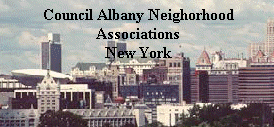ALBANY -- Mary Ellen
O'Connor's family has lived in the same Park Avenue home in the
Mansion Neighborhood since 1869.
But O'Connor, president of the Albany Public Library's Board
of Trustees, has begun looking toward the day when the front
stoop will be too much for her to negotiate.
"It's a tough situation," O'Connor said Saturday,
just one of many voices in a wide-ranging discussion on both the
assets and challenges to life in Albany's neighborhoods.
"Right now I'm thinking about the time when I'm going to
have to move out of it."
The suitability of the city's housing stock to accommodate an
aging population was just one of many issues discussed at the
Neighborhood Works conference at the First Lutheran Church,
sponsored by the Neighborhood Resource Center.
Topics ranged from the quality of the schools and the
importance of educational choices to young families to fear of
walking the streets at night in some neighborhoods, which keeps
some people away from community gatherings, to the creation of a
comprehensive plan and the appropriateness of the proposed
convention center.
Meanwhile, another effort was under way on the other side of
Albany to improve the city's quality of life Saturday. More than
50 people turned out for a march up Morton Avenue to the Martin
Luther King Jr. memorial to call for an end to violence in city
neighborhoods.
At the conference, Joann Morton, president of the South End
Neighborhood Association, discussed the necessity for parents to
get involved in their children's lives and how their involvement
acts as an engine to keep them engaged, focused and out of
trouble.
When there was nobody to coach her daughter's softball team,
she said she learned the rules and did it herself.
"We do have our weaknesses. We do have our
strengths," said Maxine Fantroy-Ford, principal at Albany
High School, a native of Albany and graduate of its schools.
"We cannot overcome our weaknesses, resolve them, if we
don't have involvement from the community."
Fantroy-Ford and others, however, overwhelmingly chose to
focus on the positive things they said make Albany an attractive
alternative to suburban life for retirees and young families.
In a school as large as Albany High, many students are
working to show the community that good things are happening in
its halls, contrary to mostly negative media reports that center
on violence. Meanwhile, she said, the staff tries to make each
student feel as though they have a place.
"Are students coming into school and somebody knows
their name?" the principal said. "It's something for
somebody to know your name."
Keynote speaker Louise McNeilly, coordinator of the Delaware
Area Neighborhood Association and executive director of the
Albany Community Land Trust, said the city's challenges --
increasing poverty, vacant buildings and unsmart growth, among
them -- are well documented.
But not enough is said about what is good, McNeilly said --
like Albany's historic buildings that feature porches and
stoops, its community gardens, parks, cultural institutions,
rich history, independent businesses, strong church community
and diversity.
What's more, said Gene Solan, president of the not-for-profit
Neighborhood Resource Center, Albany already has what many
suburban communities -- such as Colonie -- are now striving to
re-create through an overhaul of existing zoning laws: walkable,
mixed-use neighborhoods.
"We have the basic infrastructure for walking,"
Solan, also a Pine Hills resident, said of the city's sidewalks.
"We don't have to create that."
Jordan Carleo-Evangelist can be reached at 454-5445 or by
e-mail at jcarleo-evangelist@ timesunion.com.
